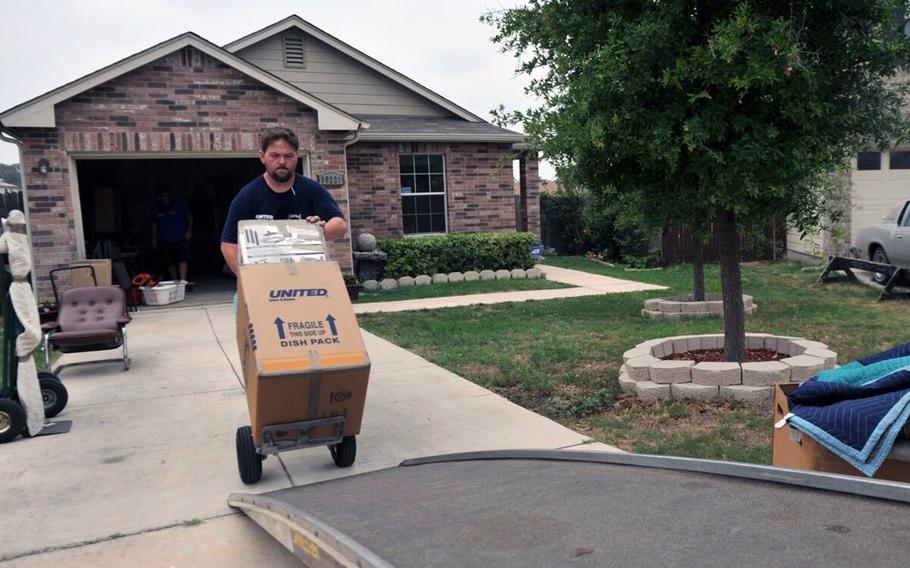
A mover rolls a service members' household goods onto a truck at Fort Knox, Ky., April 12, 2022. (U.S. Army)
About 1,000 service members have faced late pickups or deliveries of household goods under the initial phase-in of the Defense Department’s revamped system for relocations, defense officials said Thursday.
“Right now, we anticipate roughly 1,000 service members have been impacted, either at the pickup-delivery or [by] poor communication,” Andy Dawson, director of the Defense Personal Property Management Office inside U.S. Transportation Command, told reporters during a conference call.
“The majority of them have been in the last 30 to 45 days,” he said.
The Defense Department is transferring oversight of the roughly 300,000 annual moves by the military and Coast Guard to HomeSafe Alliance, a joint venture between Tier One Relocation and KBR, formerly Kellogg Brown & Root.
The Transportation Command awarded HomeSafe a $20 billion contract in late 2021 to implement the Global Household Goods Contract, or GHC.
Under GHC, HomeSafe is replacing about 900 companies that until now managed military moves by contracting with movers and trucking, shipping and warehousing companies.
Implementing GHC began in April 2024 with a handful of moves per month but has progressed with a “deliberate walk-crawl-run approach,” Dawson said. GHC is slated to handle all domestic moves by this summer, with international moves beginning in the fall.
The program has met with resistance from much of the moving industry, which objects to lower rates being offered by HomeSafe as compared to the legacy system, as well as other terms of the contract.
Regardless of problems with the rollout, the Defense Department has no intention of giving up on it.
“GHC is the department’s future household goods relocation program,” Dawson said. “We’re committed to it, and despite some early challenges, we have seen many positive aspects in GHC that we truly believe will improve our service member relocation experience.”
In an emailed statement Friday, HomeSafe said it is “focused on continuously improving all of our systems and processes.”
“While the vast majority of HomeSafe’s moves have been successful, logistical challenges have caused delays for some moves in these early stages of our program,” the email stated.
“We are implementing additional measures to strengthen our network’s agility and to minimize the risk of future delays. We are onboarding and training new highly qualified movers to service relocations. We also have several process improvements underway to enhance our 24/7 customer service.”
As of Thursday, HomeSafe has been given 5,195 relocation orders, with 1,737 of those orders picked up and 922 delivered, he said.
Those orders account for just over 1% of the approximate volume for 2025, with most moves still to come during peak moving season beginning in May.
The numbers provided by the Transportation Command suggest that about a fifth of households that have relocated using GHC have been unsatisfied with the service.
By comparison, the dissatisfaction rate was just over 23% in 2024 for domestic household moves under the legacy system, according to the Transportation Command.
“In terms of quality and capacity, we did begin to see some issues in late December, as we started to increase the volume of shipments,” Dawson said. “Mostly these have been centered around scheduling issues, missed pickups and missed delivery dates.
“We’ve been in constant contact with HomeSafe and have expressed our concern regarding these performance issues,” he said.
Many companies in the moving industry have resisted signing onto the GHC contract.
Rates being offered under GHC are on average 20% less than those under the legacy system, Kenneth Brennan, the command’s director of acquisition, told reporters.
The degree to which GHC lacks contractor capacity is something even the Transportation Command does not know.
“Due to the contract construct, I cannot quantify that capacity by metrics,” Brennan said.
“The reason is that we are contracting for an outcome via the GHC contract, just like all of our contracts,” he said. “We don’t tell the folks how to do it. We don’t necessarily need insight into how many employees they have. We just need to have the assurance that they’ve got the capacity.”
Dawson said the GHC contract creates a “tough program” in which HomeSafe is required to fulfill each and every relocation job that enters the pipeline, Dawson said.
For example, earlier this week more than a dozen service members asked to be moved the very next day, he said.
“HomeSafe is expected and required by the contract to support those moves,” Dawson said. “It was designed that way to support our service member needs.”